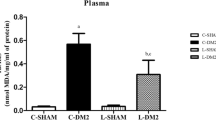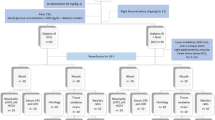Abstract
In heart failure (HF), there is an imbalance between the production of reactive oxygen species and the synthesis of antioxidant enzymes, causing damage to the cardiovascular function and increased susceptibility to DNA damage. The aim of this study was to evaluate the influence of low-level laser therapy (LLLT) on parameters of oxidative stress and DNA damage in skeletal muscle and plasma of rats with HF. Wistar rats were allocated into six groups: “placebo” HF rats (P-HF, n = 9), “placebo” Sham rats (P-sham, n = 8), HF rats at a dose 3 J/cm2 of LLLT (3 J/cm2-HF, n = 8), sham rats at a dose 3 J/cm2 of LLLT (3 J/cm2-sham, n = 8), HF rats at a dose 21 J/cm2 of LLLT (21 J/cm2-HF, n = 8) and sham rats at a dose 21 J/cm2 of LLLT (21 J/cm2-sham, n = 8). Animals were submitted to a LLLT protocol for 10 days at the right gastrocnemius muscle. Comparison between groups showed a significant reduction in superoxide dismutase (SOD) activity in the 3 J/cm2-HF group (p = 0.03) and the 21 J/cm2-HF group (p = 0.01) compared to the P-HF group. 2′,7′-Dihydrodichlorofluorescein (DCFH) oxidation levels showed a decrease when comparing 3 J/cm2-sham to P-sham (p = 0.02). The DNA damage index had a significant increase either in 21 J/cm2-HF or 21 J/cm2-sham in comparison to P-HF (p = 0.004) and P-sham (p = 0.001) and to 3 J/cm2-HF (p = 0.007) and 3 J/cm2-sham (p = 0.037), respectively. Based on this, laser therapy appears to reduce SOD activity and DCFH oxidation levels, changing the oxidative balance in the skeletal muscle of HF rats. Otherwise, high doses of LLLT seem to increase DNA damage.





Similar content being viewed by others
References
MacIver DH, Dayer MJ (2012) An alternative approach to understanding the pathophysiological mechanisms of chronic heart failure. Int J Cardiol 154(2):102–110
Working Group on Cardiac Rehabilitation and Exercise Physiology and Working Group on Heart Failure of the European Society of Cardiology (2001) Recommendations for exercise training in chronic heart failure patients. Eur Heart J
Tsutsui H, Ide T, Hayashidani S, Suematsu N, Shiomi T, Wen J, Nakamura K, Ichikawa K, Utsumi H, Takeshita A (2001) Enhanced generation of reactive oxygen species in the limb skeletal muscles from a murine infarct model of heart failure. Circulation 104:134–136
Hambrecht R, Fiehn E, Weigl C, Gielen S, Hamann C, Kaiser R, Yu J, Adams V, Niebauer J, Schuler G (1998) Regular physical exercise corrects endothelial dysfunction and improves exercise capacity in patients with chronic heart failure. Circulation 98:2709–2715
McCord JM (1985) Oxygen-derived free radicals in post-ischemic tissue injury. N Engl J Med 312:159–163
Chen H, Hu CJ, He YY, Yang DI, Xu J, Hsu CY (2001) Reduction and restoration of mitochondrial DNA content after focal cerebral ischemia/reperfusion. Stroke 32:2382–2387
Tsuitsui H, Kinugawa S, Matsushima S (2008) Oxidative stress and mitochondrial DNA damage in heart failure. Circ J Suppl A:A-31–A-37
Nishiyama Y, Ikeda H, Haramaki N, Yoshida N, Imaizumi T (1998) Oxidative stress is related to exercise intolerance in patients with heart failure. Am Heart J 135:115–120
Albertini R, Villaverde AB, Aimbire F et al (2008) Cytokine mRNA expression is decreased in the subplantar muscle of rat paw subjected to carrageenan-induced inflammation after low-level laser therapy. Photomed Laser Surg 26:19–24
Bortone F, Santos HA, Albertini R, Pesquero JB, Costa MS, Silva JA Jr (2008) Low level laser therapy modulates kinin receptors mRNA expression in the subplantar muscle of rat paw subjected to carrageenan-induced inflammation. Int Immunopharmacol 8:206–210
Liu XG, Zhou YJ, Liu TC, Yuan JQ (2009) Effects of low-level laser irradiation on rat skeletal muscle injury after eccentric exercise. Photomed Laser Surg 27:863–869
Xu X, Zhao X, Liu TC, Pan H (2008) Low-intensity laser irradiation improves the mitochondrial dysfunction of C2C12 induced by electrical stimulation. Photomed Laser Surg 26:197–202
Silveira PC, Silva LA, Fraga DB, Freitas TP, Streck EL, Pinho R (2009) Evaluation of mitochondrial respiratory chain activity in muscle healing by low-level laser therapy. J Photochem Photobiol B 95:89–92
Tullberg M, Alstergren PJ, Ernberg MM (2003) Effects of low-power laser exposure on masseter muscle pain and microcirculation. Pain 105(1–2):89–96
Hentschke VS, Jaenisch RB, Schmeing LA, Cavinato PR, Xavier LL, Dal Lago P (2013) Low-level laser therapy improves the inflammatory profile of rats with heart failure. Lasers Med Sci 28(3):1007–1016
Avni D, Levkovitz S, Maltz L, Oron U (2005) Protection of skeletal muscles from ischemic injury: low level laser therapy increases antioxidant activity. Photomed Laser Surg 23:273–277
Rizzi CF, Mauriz JL, Freitas Correa DS et al (2006) Effects of low-level laser therapy (LLLT) on the nuclear factor (NF)-kappaB signalling pathway in traumatized muscle. Lasers Surg Med 38:704–713
Junior ECPL, Lopes-Martins RAB, Frigo L, De Marchi T, Rossi RP, Godoi V, Tomazoni SS, Silva DP, Basso M, Filho PL, Corsetti FV, Iversen VV, Bjordal JM (2010) Effects of low-level laser therapy (LLLT) in the development of exercise-induced skeletal muscle fatigue and changes in biochemical markers related to post-exercise recovery. J Orthop Sports Phys Ther 40(8):524–532
Pfeffer MA, Pfeffer JM, Fishbein MC, Fletcher PJ, Spadaro J, Kloner RA, Braunwald E (1979) Myocardial infarct size and ventricular function in rats. Circ Res 44(4):503–512
Jaenisch RB, Hentschke VS, Quagliotto E, Cavinato PR, Schmeing LA, Xavier LL, Dal Lago P (2011) Respiratory muscle training improves haemodynamics, autonomic function, baroreceptor sensitivity, and respiratory mechanics in rats with heart failure. J Appl Physiol 111(6):1664–1670
Francis J, Weiss RM, Wei SG, Johnson AK, Felder RB (2001) Progression of heart failure after myocardial infarction in the rat. Am J Physiol Regul Integr Comp Physiol 281(5):R1734–R1745
Lowry OH, Rosebrough N, Farr AL, Randal RJ (1951) Protein measurement with a folin phenol reagent. J Biol Chem 193:265–275
LeBel CP, Ischiropoulos H, Bondy SC (1992) Evaluation of the probe 2′,7′ dichlorofluorescin as an indicator of reactive oxygen species formation and oxidative stress. Chem Res Toxicol 5:227–231
Marklund SL (1985) Pyrogallol autoxidation. In: Greenwald RA, editor Handbook of methods for oxygen radical research. CRC Press Inc. p. 243–7
Wendel A (1981) Gluthathione peroxidise. Methods Enzymol 77:325–333
Olive PL, Banath JP (2006) The comet assay: a method to measure DNA damage in individual cells. Nat Protoc 1(1):23–29
Nadin SB, Vargas-Roig LM, Ciocca DR (2001) A silver staining method for single-cell gel assay. J Histochem Cytochem 49(9):1183–1186
Burlinson B, Tice RR, Speit G, Agurell E, Brendler-Schwaab SY, Collins AR, Escobar P, Honma M, Kumaravel TS, Nakajima M, Sasaki YF, Thybaud V, Uno Y, Vasquez M, Hartmann A (2007) Fourth International Workgroup on Genotoxicity testing: results of the in vivo Comet assay workgroup. Mutat Res 627(1):31–35
Huang YY, Chen AC, Carroll JD, Hamblin MR (2009) Biphasic dose response in low-level light therapy. Dose Response 7:358–383
Kaur K, Dhingra S, Slezak J, Sharma AK, Bajaj A, Singal PK (2009) Biology of TNF-alpha and IL-10, and their imbalance in heart failure. Heart Fail Rev 14(2):113–123
Sharma R, Coats AJ, Anker SD (2000) The role of inflammatory mediators in chronic heart failure: cytokines, nitric oxide, and endothelin-1. Int J Cardiol 72(2):175–186
Galle J (2001) Oxidative stress in chronic renal failure. Nephrol Dial Transplant 16(11):2135–2137
Gielen S et al (2005) Exercise training in chronic heart failure: correlation between reduced local inflammation and improved oxidative capacity in the skeletal muscle. Eur J Cardiovasc Prev Rehabil 12(4):393–400
Packer L, Wiltf EH, Tritschler HJ (2010) Alpha-lipoic acid as a biological antioxidant. Free Radic Biol Med 19(2):227–250
Fillipin LI, Mauriz JL, Vedovelli K, Moreira AJ, Zettler CG, Lech O, Marroni NP, González-Gallego J (2005) Low-level laser therapy (LLLT) prevents oxidative stress and reduces fibroses in rat traumatized Achilles tendon. Lasers Surg Med 37:293–300
Fonseca AS, Moreira TO, Paixão DL, Farias FM, Guimarães OR, Paoli S, Geller M, Paoli F (2010) Effect of laser therapy on DNA damage. Lasers Surg Med 42:481–488
Conflicts of interest
None
Author information
Authors and Affiliations
Corresponding author
Rights and permissions
About this article
Cite this article
Biasibetti, M., Rojas, D.B., Hentschke, V.S. et al. The influence of low-level laser therapy on parameters of oxidative stress and DNA damage on muscle and plasma in rats with heart failure. Lasers Med Sci 29, 1895–1906 (2014). https://doi.org/10.1007/s10103-014-1597-1
Received:
Accepted:
Published:
Issue Date:
DOI: https://doi.org/10.1007/s10103-014-1597-1




